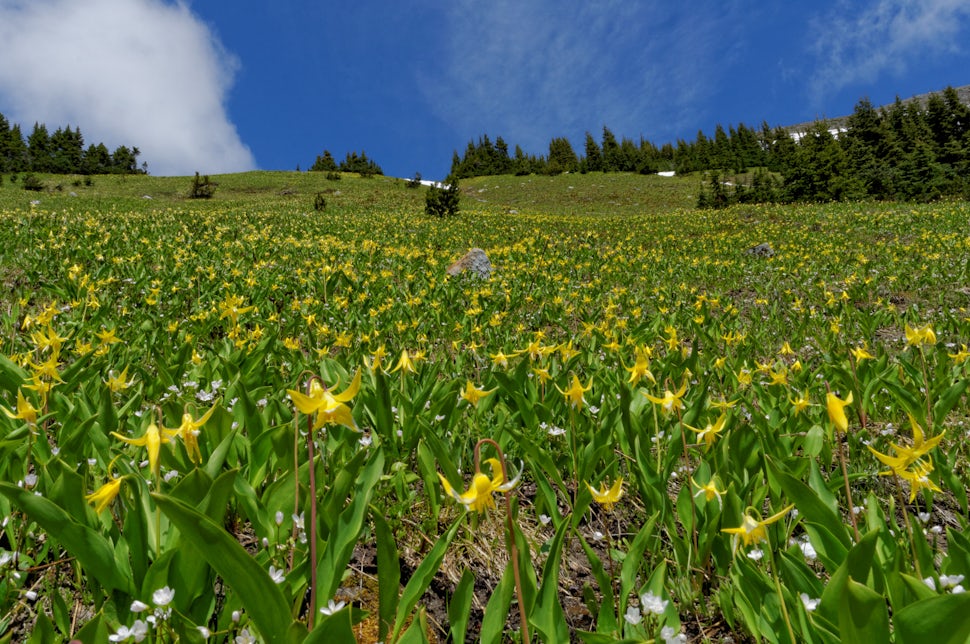
After a decade of hiking the mountains of south-western British Columbia I've come to realize that as much as I love reaching mountain summits, it is the array of wildflowers that really inspires me to head into the backcountry each summer. With the help of a camera and a superb guide book, I've learned over 100 species of flowers that grow from sea level up to 2500 m (8200 ft) and above. I've learned when (and where) to expect each type of flower to bloom, and can track the progress of the season just by which flowers are blooming.
A few species have caught my eye over the years - orchids, lilies, daisies, etc - and I'm quite partial to partridgefoot and monkeyflower. But one flower stands out as my all-time favourite: the glacier lily.
Erythronium grandiflorum is a diminutive yellow flower that blooms as the snow melts; a flower that disappears from view within a couple of weeks to be replaced by the main floral display of lupines, paintbrush, and others. As such most hikers never even see glacier lilies, including some of my friends who are somewhat perplexed by my obsession (yes, I admit - it's an obsession!).
And so, every May I start to pay close attention to the snowpack. How deep is it? Where is it thinnest? How quickly is it melting? Where are the south-facing slopes at just the right elevation that could be snow-free? I have a mental list of hikes where I know glacier lilies grow and I add to it as I read more trip reports. Each year I try to either visit somewhere new, or pick a familiar place at the perfect moment.
But why these flowers in particular? Why not western anemone? Spring beauty? These too are early spring flowers and just as ephemeral. To me it's simple: when they bloom, glacier lilies can literally carpet an entire meadow or hillside. This sea of cheery, bright yellow, often against a deep blue sky, is the very antithesis of the Vancouver winter. This explosion of light and colour is supremely uplifting, perhaps even spiritually so. It signals the beginning of the alpine hiking season, the sensory gifts of nature which we endeavour to absorb in order to keep us going through all the grey weather.
It also signals the beginning of bug season, those itchy Sundays-to-Thursdays that are all forgiven and forgotten by Saturday morning. OK so maybe I don't look forward to that part, but the rest is pure awesome. However, without the bugs there are no flowers so that is something we just have to deal with.
"Glacier lilies!" is a familiar refrain to my hiking friends, betraying my country of birth by pronouncing it 'glass-ee-ur'. It's a cue to expect progress to grind to a halt as the camera is fired up and put into action. After all, I'm always searching for that perfect shot...
And yet, despite their abundance, photographing them is deceptively hard. Well, kinda. It's quite easy to get a good photo of a single flower, or a small cluster. Compact cameras are much better than they used to be when it comes to focusing on a yellow flower against a green background. Digital SLRs are more capable, albeit at the expense of depth-of-field. However, it's much harder to effectively capture the great expanse of yellow that is so impressive to the eye. I'm still working on it - I just need to find that perfect patch....!
In 2016, my first glacier lily sightings were on Thurston Peak near Chilliwack, a small patch that partly redeemed its viewless summit. Some were barely bigger than my thumbnail. A week later I was treated to the full-on glory of peak bloom in the Downton Creek basin, perhaps the best display I've seen for a few years. Better yet, within only 24 hours I was able to see new shoots appear as a patch of snow melted in the heat.
Seek them out on southerly aspects, usually just above the treeline at elevations between 1700 and 2200 m (5600 to 7200 ft), although I have seen them as low as about 1450 m (4750 ft). I've seen them bloom at the end of May and into the latter half of August - it all depends on the snow.
Of course, BC isn't the only place to find glacier lilies: they are abundant in the Canadian Rockies and North Cascades. The Olympics and Mt Rainier are famed for their glorious displays of avalanche lilies, a close relation that is mostly white.
Get out there now as they'll be gone before you know it!
We want to acknowledge and thank the past, present, and future generations of all Native Nations and Indigenous Peoples whose ancestral lands we travel, explore, and play on. Always practice Leave No Trace ethics on your adventures and follow local regulations. Please explore responsibly!
Do you love the outdoors?
Yep, us too. That's why we send you the best local adventures, stories, and expert advice, right to your inbox.








